Fix UNMOUNTABLE_BOOT_VOLUME error in Windows
Today's article will share with you the information about the causes and possible solutions to fix the blue screen death-related error (BSOD), UNMOUNTABLE_BOOT_VOLUME and stop code is STOP: 0x000000ED.
This error is sometimes misspelled to UNMOUNTABLE_BOOT_DRIVE, but functionally the two errors are the same.
The fix described in the article applies to Windows XP, Windows Vista and Windows 7.
Instructions for troubleshooting UNMOUNTABLE_BOOT_VOLUME error
- Overview of UNMOUNTABLE_BOOT_VOLUME error
- Description and identification signs
- The cause of the UNMOUNTABLE_BOOT_VOLUME error
- Error correction 'UNMOUNTABLE BOOT VOLUME BSOD' on Windows
- How to fix 1: Roll back the driver controller drive with System Restore
- Solution 2: Change IDE / RAID / AHCI mode in BIOS
Overview of UNMOUNTABLE_BOOT_VOLUME error
The following information about this error has been compiled, based on information gathered by global engineers, developers and technicians or organizations.
Description and identification signs
When booting a PC running Windows XP, Windows Vista or Windows 7, you may encounter a blue screen of death (BSOD) with an error message, UNMOUNTABLE_BOOT_VOLUME, and usually a stop code STOP: 0x000000ED, similar to a screenshot underneath:

Sometimes the error message also has another 'variant' as follows:

The cause of the UNMOUNTABLE_BOOT_VOLUME error
The UNMOUNTABLE_BOOT_VOLUME error is a sign that Windows cannot mount the boot file system to read / download the necessary dependencies from there.
While Windows, based on the microkernel-esque structure, can load dependencies and components flexibly, has a basic dependency set, it must be absolutely online in the boot process, otherwise Windows will not boot, even if the kernel is issued.
With the latest Windows versions and especially after the kernel and driver reconstruction that took place during Windows Vista development, this list of components has been reduced and now includes only input / output drivers. Basic and most popular). In general, the basic input / output drivers are able to work with different systems without requiring any special compatibility, since most of the hardware they connect has been designed and build to the standard - even if not everyone complies with RFC and other official standards, in addition to controllers for hard drive drivers.
If Windows cannot determine and connect to the hard drive controller (whether integrated into the motherboard or as a PCI-E card) or if the hard drive controller is successfully online but Windows cannot read the drive It is being booted from there for various reasons, such as the UNMOUNTABLE_BOOT_VOLUME error that may appear.
This error occurs due to one or more of the following:
Cause 1: Driver drive controller is corrupted or incompatible
As explained above, if Windows cannot determine and connect to the hard drive controller, responsible for the drive where the system partition is located, the Windows kernel will not be able to read and load the basic dependencies from the drive, therefore, the blue screen above will appear.
A common cause of this error is to uninstall or update / upgrade failed hard drive controller drivers.
For example, if the Intel or LSI drive management driver is deleted, corrupted, uninstalled or upgraded incorrectly and Windows has no 'original', basic support for a specific hard drive controller is in use, Windows will not be able to communicate with the drive adapter to read the required data, resulting in a deadly blue screen error UNMOUNTABLE_BOOT_VOLUME.
Cause 2: Try to load Windows from an incorrect partition
If Windows cannot load the main drivers and other basic dependencies, the UNMOUNTABLE_BOOT_VOLUME error will also occur, in case Windows requires the driver to connect to the hard drive controller, but is instructed to load from the wrong partition (not is the real installed partition). When the bootloader (NTLDR in the case of Windows XP or BOOTMGR in the case of Windows Vista and Windows 7) starts loading the operating system based on the configuration file (The configuration is stored in the BOOT.ini text file in the case of NTLDR and BOOTBCD BOOTBCD in BOOTMGR case , the bootloader will transfer information about where it will load the operating system to the kernel (in the environment block).
If the configuration repository (BOOT.INI / BCD) is incorrectly set or no longer points to the correct partition, ntoskrnl will not be able to load Windows from the specified partition and there may be BSOD UNMOUNTABLE_BOOT_VOLUME errors.
Cause 3: The Windows partition is resized or moved
In a manner similar to the situation with BCD or BOOT.INI incorrectly configured, instructing Windows kernel to load the operating system from the wrong partition, the UNMOUNTABLE_BOOT_VOLUME error may also occur if the identifier for the Windows partition is changed. change, but the boot configuration file still holds the old information.
Both NTLDR and BOOTMGR have many methods of determining partitions. Some methods are based on a combination of drive numbers and offset partitions (distance from the drive's starting point) or partition number (how many partitions stand before it physically in the drive layout sequential or in partition table in MBR).
If the Windows partition is moved, a partition is added or deleted before the Windows partition is placed on the drive, or the order of the drives changes, the BCD or BOOT.INI references to the Windows partition may not yes, and the kernel will issue a blue screen death error UNMOUNTABL_BOOT_VOLUME when trying to load Windows from the wrong partition.
Cause 4: SATA mode AHCI / IDE / RAID is changed or reconfigured
Similar to the first scenario discussed above, where the device drivers needed to communicate with the Windows partition have been uninstalled or replaced incorrectly, maybe the drivers that Windows has been configured to load and use at the start of the boot process is no longer correct, although the basic hardware has not changed. Most SATA controllers (Intel ICH ACH controller, Marvell, JMicron, nVidia and other controllers) display an option in the BIOS for the drive controller configured in any of three modes: IDE, AHCI or RAID.
The IDE is the most basic mode and handles SATA controllers in the same way as the legacy IDE controllers that handled ATA drives: This controller itself has almost no logic related to reading / writing and simply plays bridge (proxy data to and from drives).
AHCI is a new standard for communication, first used in home PCs, for drives connected to SATA controllers on newer operating systems, in which the hard drive controller contains an important logical link. refers to the process of reading and writing.
Instead of asking the Windows device driver to dictate each move of the read / write head and finding the drive, the controller in AHCI mode will act as the "scribe" of the above information for Windows, receive higher-level read and write commands and then use your own logic to process the commands as efficiently as possible (allowing hardware-level caching, optimizing the read / write order (called NCQ) to minimize disk search, reduce latency and optimize other components).
Newer SATA controllers have RAID mode, in which RAID is deployed on most software, used to set up 'stripe' drives for performance, RAID 1 ('mirror') to Data backup or RAID 5/6/1 + 0 for both purposes. Typically, such configuration will require a completely separate hardware-based RAID controller, but the modern SATA drive controller divides the RAID process between the device driver and the microcontroller on the board for a cost-effective solution. charge.
As can be seen, the above three modes of operation vary quite a lot in terms of features and implementation. Each of these modes requires a completely different driver for Windows to use, although the hardware itself (both the physical drive controller and the hard drive) does not change.
Most computers allow IDE / AHCI / RAID mode to be installed from the BIOS and change quickly without having to delete the hard drive. If Windows is installed and started with this mode, but another mode is configured (due to BIOS configuration changes, BIOS upgrades, BIOS reset settings, etc.), the current driver will no longer be available. Enough to use.
Error correction 'UNMOUNTABLE BOOT VOLUME BSOD' on Windows
Some solutions below require using a CD or DVD to set up Microsoft Windows. If the PC is not included with the Windows installation disc, or if you no longer have the Windows setup facility available, you can use Easy Recovery Essentials for Windows instead. EasyRE will automatically find and fix many problems and can also be used to solve problems related to the UNMOUNTABLE_BOOT_VOLUME error according to the instructions below.
How to fix 1: Roll back the driver controller drive with System Restore
Most of the drivers related to this error can be corrected by returning to the previous system configuration using the System Restore tool.
Windows usually creates a system restore point every time certain drivers are installed, upgraded or deleted. If the UNMOUNTABLE_BOOT_VOLUME error is caused by a device driver change, the system restore point will 'reverse' the process and help correct the error.
System Restore, available from Startup Repair / Recovery Console , is released on Windows Vista, Windows 7 and Windows 8 setup DVDs, which can be used to display a list of 'snapshots' on the computer at recently and tried to restore the PC to the selected restore point. System Restore is 'non-destructive', because it only affects Windows and programs, not individual files and folders. Follow these instructions:
1. Insert the Windows installation DVD into the PC CD-ROM drive,
2. Turn off the PC completely.
3. Turn on the PC power again,
4. Press any key when you see the message 'Press any key to boot from CD or DVD' .
5. Click the link titled 'Repair your computer' in the bottom left corner, after selecting the language and keyboard options.
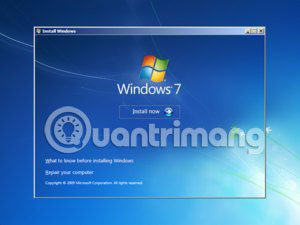
6. Wait for Startup Repair to scan your PC to install Windows, then select the installation from the list that it displays:
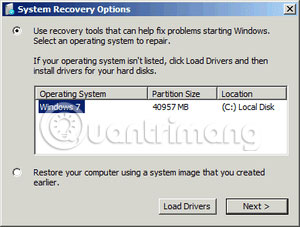
7. Select 'System Restore' from the list of recovery options available to get started:

8. The 'System Restore' utility will launch, giving you the ability to select the previous desired system restore point or providing manual options, then click Next to continue.
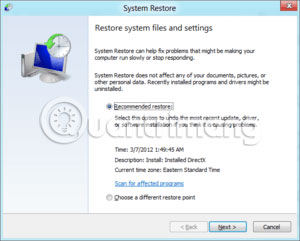
9. Depending on your selection, you may be provided with a list of valid system restore points and their respective dates, plus a brief description of why (if any) they are available. perform. Click the desired option, then select Next again to continue.
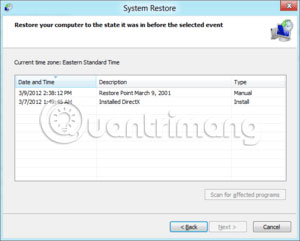
10. System Restore will ask you to confirm your choice and then start the recovery process. You will be prompted to exit and restart the computer for the restore to complete.
After the PC restarts, if System Restore is completed successfully, the PC will fix the error and System Restore will notify you of the changes it has made to the PC after you log back into Windows. . If the system recovery process fails or if the system recovery process is completed successfully, but the problem is not resolved, you can repeat the steps above but select another restore point, see if the error has been etched. dress.
Solution 2: Change IDE / RAID / AHCI mode in BIOS
If the UNMOUNTABLE_BOOT_DEVICE error occurs because of changing the mode of the SATA drive controller in the BIOS or firmware, the fix may be very simple, by entering the BIOS and switching the mode settings of the SATA controller. Specific instructions will vary depending on the manufacturer, but the options will be similar to those shown in the screenshot below.
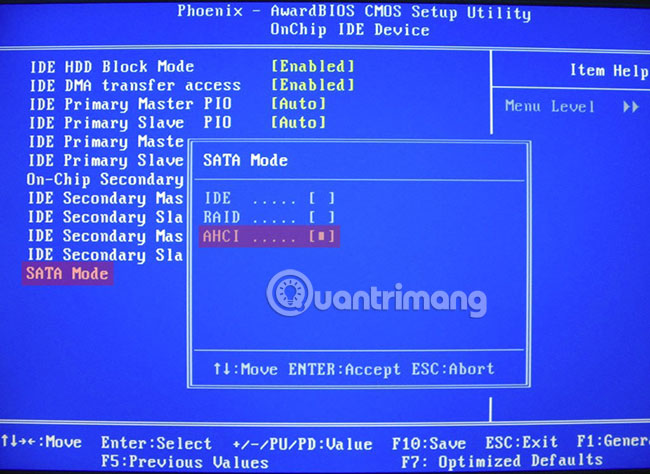

Try switching between 3 modes until Windows can successfully boot.
Hope you are succesful.
You should read it
- How to fix 'This App Can't Run on Your PC' error on Windows 10
- How to fix 403 Forbidden Error
- Summary of iOS 17 errors and how to fix them
- Learn about error code 0xc00000e and how to fix it
- Instructions on how to fix 53 error when restoring on iPhone
- Steps to fix error 0x8004FC12 on Windows 11
- How to fix the Disk I / O error in Windows
- How to fix the disconnection error when playing League of Legends on your computer
May be interested
- 5 most common Windows errors and this is a fix
 how many windows errors have you encountered when using a computer? it is frustrating to see error messages because they are often unclear and do not provide a way to fix specific errors. this article will summarize the 5 most common windows errors and how to fix them.
how many windows errors have you encountered when using a computer? it is frustrating to see error messages because they are often unclear and do not provide a way to fix specific errors. this article will summarize the 5 most common windows errors and how to fix them. - 0x80072F8F error when Activation Windows 7 and Vista, this is how to fix it
 windows activation error 0x80072f8f usually occurs during activation of windows 7 or windows vista. the cause of the error may be due to incorrect date and time settings on the system, or other reasons. in the article below, network administrator will guide you through several ways to fix this error.
windows activation error 0x80072f8f usually occurs during activation of windows 7 or windows vista. the cause of the error may be due to incorrect date and time settings on the system, or other reasons. in the article below, network administrator will guide you through several ways to fix this error. - 5 easy ways to fix nvlddmkm.sys error in Windows 10
 the nvlddmkm.sys blue screen error (also known as video tdr failure) has happened to many windows users, most of whom also happen to be using nvidia gpus.
the nvlddmkm.sys blue screen error (also known as video tdr failure) has happened to many windows users, most of whom also happen to be using nvidia gpus. - How to fix Windows error code 0xc000000f
 error code 0xc000000f is a common error on windows pcs. often accompanied by messages like 'windows failed to start' or 'your pc needs to be repaired', are blue screen of death (bsod) errors that no user wants to see.
error code 0xc000000f is a common error on windows pcs. often accompanied by messages like 'windows failed to start' or 'your pc needs to be repaired', are blue screen of death (bsod) errors that no user wants to see. - 9 Windows 8.1 errors have not been resolved
 with the application of new functions such as boot straight into desktop, refreshing the app store and using multiple windows for modern applications, windows 8.1 feels like a new step compared to its predecessor windows 8. although however, there is a question: why doesn't microsoft call it windows 8.5 or windows 9? .
with the application of new functions such as boot straight into desktop, refreshing the app store and using multiple windows for modern applications, windows 8.1 feels like a new step compared to its predecessor windows 8. although however, there is a question: why doesn't microsoft call it windows 8.5 or windows 9? . - How to fix 'PC Name Is Invalid' error on Windows 11
 an example is seeing the error message 'pc name is invalid' displayed on the screen. this error can be quite annoying to encounter as it prevents you from renaming your pc.
an example is seeing the error message 'pc name is invalid' displayed on the screen. this error can be quite annoying to encounter as it prevents you from renaming your pc. - Summary of some ways to fix Windows 10 crash, BSOD error and restart error
 there are many causes that your windows 10 computer crashes, crashes or even reboots itself such as hardware errors, software errors, system failure or due to programs, anti-software virus on your computer .... during use, if unfortunately your windows 10 computer hangs, freezes ... will make you feel very uncomfortable and work efficiency will be reduced due to interruption.
there are many causes that your windows 10 computer crashes, crashes or even reboots itself such as hardware errors, software errors, system failure or due to programs, anti-software virus on your computer .... during use, if unfortunately your windows 10 computer hangs, freezes ... will make you feel very uncomfortable and work efficiency will be reduced due to interruption. - Taskbar on Windows 10 does not work, this is a fix
 a taskbar error that is suspended, unresponsive or inactive is one of the common errors that many windows 10 users have. to fix this error, please refer to the following article of network administrator.
a taskbar error that is suspended, unresponsive or inactive is one of the common errors that many windows 10 users have. to fix this error, please refer to the following article of network administrator. - How to handle the error Windows 11 does not receive enough RAM
 your windows 11 reports an error that does not receive enough ram, lacks ram while the machine's ram is still available. this article will help you handle this situation quickly.
your windows 11 reports an error that does not receive enough ram, lacks ram while the machine's ram is still available. this article will help you handle this situation quickly. - How to fix Windows Update error 0x80190001
 briwindows update is an important component of the windows operating system that keeps the system up to date with the latest security patches and fixes. while these updates are generally helpful, they can cause windows to misbehave or display error messages.
briwindows update is an important component of the windows operating system that keeps the system up to date with the latest security patches and fixes. while these updates are generally helpful, they can cause windows to misbehave or display error messages.










 Fix the error 0x100000ea (THREAD STUCK IN DEVICE DRIVER M) in Windows
Fix the error 0x100000ea (THREAD STUCK IN DEVICE DRIVER M) in Windows How to fix 0x0000007F (UNEXPECTED KERNEL MODE TRAP) error in Windows
How to fix 0x0000007F (UNEXPECTED KERNEL MODE TRAP) error in Windows How to update SupportAssist on a Dell device
How to update SupportAssist on a Dell device 6 addresses to save professional data
6 addresses to save professional data Fix error 0x0000006B: PROCESS1_INITIALIZATION_FAILED in Windows
Fix error 0x0000006B: PROCESS1_INITIALIZATION_FAILED in Windows Summary of errors that cannot reach the network and how to fix errors on the computer
Summary of errors that cannot reach the network and how to fix errors on the computer